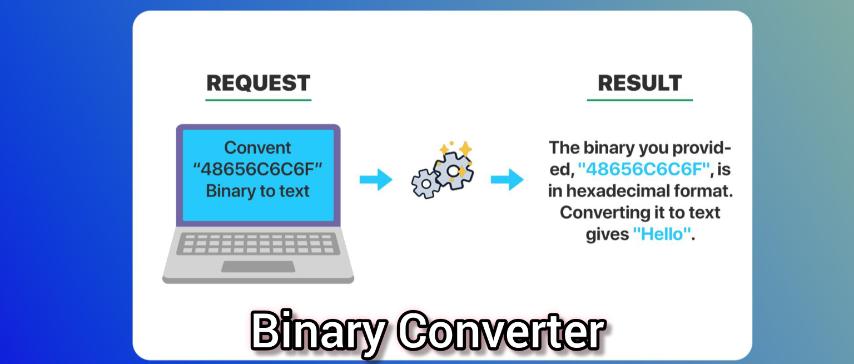
Binary Converter: A Simple Guide to Number System Conversion
Created on 1 October, 2025 • Converter Tools • 19 views • 2 minutes read
A binary converter is an essential tool for students, programmers, and anyone dealing with digital data.
The binary system is one of the most important foundations of modern computing. It uses only two digits, 0 and 1, to represent data, making it the language that computers understand. However, humans often work with decimal, hexadecimal, or text-based formats. That’s where a binary converter comes in. It is a tool that allows easy conversion between binary numbers and other formats like decimal, octal, hexadecimal, or even ASCII text.
What Is a Binary Converter?
A binary converter is a digital tool used to transform binary numbers into other number systems and vice versa. Since binary is not always convenient for humans to read or calculate, conversion helps bridge the gap between human-friendly numbers and machine-friendly data.
The most common conversions include:
- Binary to Decimal: Converting binary code into standard base-10 numbers.
- Decimal to Binary: Changing human-readable numbers into binary code.
- Binary to Hexadecimal: Useful in programming, where hex simplifies large binary values.
- Binary to Text (ASCII): Translating binary sequences into readable text characters.
Why Use a Binary Converter?
1. Programming and Development
Developers often work with low-level data where binary, hex, and decimal formats must be converted for debugging and analysis.
2. Learning and Education
Students studying computer science or mathematics use binary converters to better understand how number systems work.
3. Data Communication
Binary converters help when dealing with networking, encryption, and encoding, where data may appear in binary form but needs to be interpreted as text or numbers.
How Does a Binary Converter Work?
A binary converter applies mathematical rules of number systems to translate values. For example:
- Binary to Decimal: Each binary digit represents a power of 2. For example,
1011in binary equals (1×2³) + (0×2²) + (1×2¹) + (1×2⁰) = 11 in decimal. - Decimal to Binary: The decimal number is repeatedly divided by 2, and the remainders form the binary sequence.
- Binary to Hexadecimal: Every 4 binary digits are grouped into one hexadecimal digit, making it shorter and easier to read.
- Binary to Text: The binary sequence is grouped into 8 bits (one byte), which represents an ASCII character like letters, numbers, or symbols.
Most online binary converters handle these calculations instantly, saving time and reducing errors.
Benefits of Using Online Binary Converter Tools
Accuracy and Speed
Manual conversion can be confusing, especially with large binary numbers. Online tools provide instant, accurate results.
User-Friendly
Even beginners with little knowledge of binary can easily convert values by entering a number and clicking convert.
Multi-Conversion Options
Many converters allow conversions between multiple formats—binary, decimal, octal, hexadecimal, and text—all in one place.
Conclusion
A binary converter is an essential tool for students, programmers, and anyone dealing with digital data. It makes working with binary numbers much easier by providing quick and accurate conversions to decimal, hexadecimal, octal, or text. Whether you’re learning computer basics, coding software, or analyzing digital communication, a binary converter helps bridge the gap between human understanding and computer logic.
If you want to simplify number system conversions and avoid manual errors, using a reliable binary converter is the smartest choice.